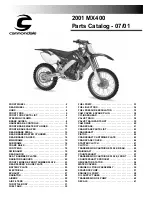
ROYAL ENFIELD WORKSHOP MANUAL
The fork is filled with a light oil (S.A.E. 20) to a
point above the lower end of the spring so that the
damper chamber "B" is always kept full of oil.
Upward movement of the wheel spindle forces oil
from the lower chamber "A" through the annular
space between the spring stud (38067) and the bore of
the main tube valve port (38138) into the damper
chamber "B." During this stroke the pressure on the
underside of the valve plate (38073) causes this to lift
so that oil can also pass from "A" to "B" through the
eight holes in the valve body. Since, however, the
diameter of chamber "B" is less than that of chamber
"A" there is not room in "B" to receive all the oil
which must be displaced from "A" as the fork
operates. The surplus oil passes through the cross hole
in the spring stud and up the centre hole in the stud,
spilling out through the nut (38076) which secures the
upper end of the spring stud to the bronze guide at the
lower end of the fork spring.
On the rebound stroke the oil in the damper
chamber "B" is forced through the annular space
between the spring stud and the bore of the main tube
valve port. During this stroke pressure in chamber
"B" closes the two disc valves at the upper and lower
ends of the chamber so that the only path through
which the oil can escape is the annular space between
the spring stud and the port. Damping on the rebound
stroke is therefore heavier than on the bump stroke.
At the extreme end of either bump or rebound stroke
a small taper portion on the spring stud enters the
bore of the valve port thus restricting the annular
space and increasing the amount of damping. At the
extreme end of the bump stroke the larger diameter
taper on the oil control collar (38075) enters the main
counterbore of the valve port thus forming a
hydraulic cushion to prevent metal to metal contact.
3. Dismantling the Fork to Replace Spring, Oil
Seal or Bearing Bushes
Place the machine on the centre stand, disconnect
the front brake control and remove the front wheel
and mudguard complete with stays. Unscrew the
bottom spring stud nut (38080) which will allow oil to
run out of the fork down to the level of the cross hole
in the spring stud.
Now knock the spring stud
upwards into the fork with a soft mallet, thus allowing
the remainder of the oil to escape. Pull the fork
bottom tube down as far as possible, thus exposing
the oil seal housing (38157). Unscrew this housing
either by means of a spanner on the flats with which it
is provided or by using the gland nut hand grips
(E4912). The bottom tube can now be withdrawn
completely from the main tube, leaving the bottom
tube bush, oil seal housing and oil seal in position on
the main tube.
Now unscrew the main tube valve port using "C"
spanner (E5418). The spring stud and spring can now
be withdrawn from the lower end of the main tube.
The steel main tube bush (38156) can now be
tapped off the lower end of the tube, if necessary
using the bottom tube bush for this purpose. Before
doing this, however, it is advisable to mark the
position of the bush with a pencil line so as to ensure
reassembling it in the same position on the main tube.
The reason for this is that these bushes are finish
ground to size after fitting on to the tubes so as to
ensure concentricity. After removal of the main tube
bush the bottom tube bush, oil seal housing and oil
seal can be removed.
In case of difficulty in removing the main tube
bush it is possible to withdraw the oil seal housing
from the upper end after removal of the main tube
from the fork head and fork crown, as described in
paragraphs 6 and 7.
4. Spring
Solo and sidecar springs are available. The free
length of each is 20.1/2 in. The spring should be
replaced if it has closed by more than 1 inch.
SHOWING THE POSITIONS OF THE CLAMP
BOLTS SECURING THE STEERING STEM AND
FORK TUBES
Fig. 7
Section J3 Page 2
www.hitchcocksmotorcycles.com
Summary of Contents for 350 BULLET 1949
Page 7: ...ROYAL ENFIELD WORKSHOP MANUAL w w w h i t c h c o c k s m o t o r c y c l e s c o m ...
Page 53: ...ROYAL ENFIELD WORKSHOP MANUAL w w w h i t c h c o c k s m o t o r c y c l e s c o m ...
Page 59: ...ROYAL ENFIELD WORKSHOP MANUAL w w w h i t c h c o c k s m o t o r c y c l e s c o m ...
Page 71: ...ROYAL ENFIELD WORKSHOP MANUAL w w w h i t c h c o c k s m o t o r c y c l e s c o m ...
Page 81: ...ROYAL ENFIELD WORKSHOP MANUAL w w w h i t c h c o c k s m o t o r c y c l e s c o m ...
Page 100: ...ROYAL ENFIELD WORKSHOP MANUAL NOTES w w w h i t c h c o c k s m o t o r c y c l e s c o m ...
Page 101: ...ROYAL ENFIELD WORKSHOP MANUAL NOTES w w w h i t c h c o c k s m o t o r c y c l e s c o m ...
















































